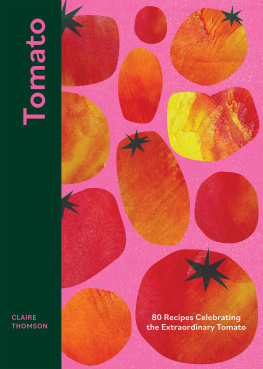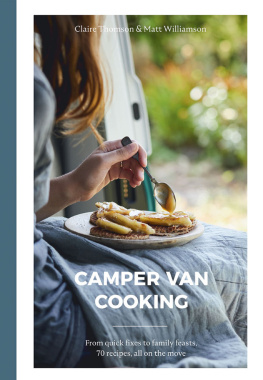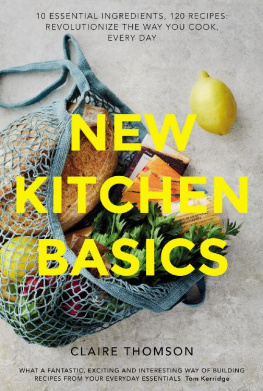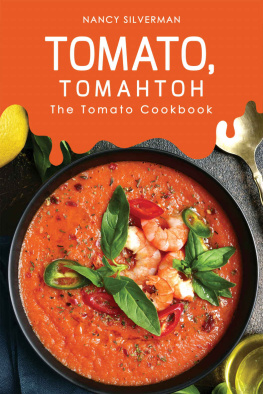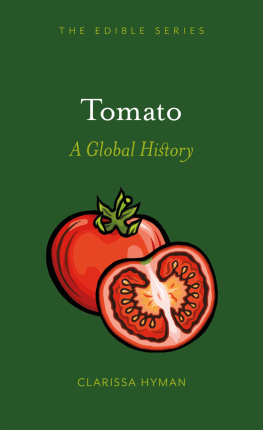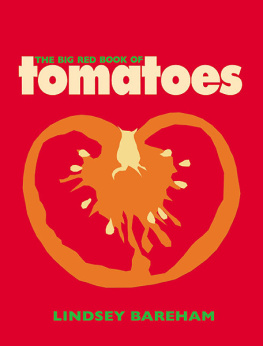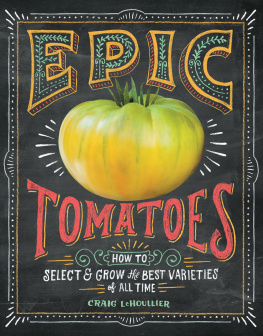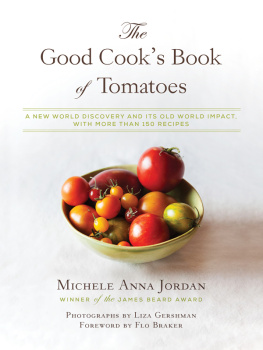
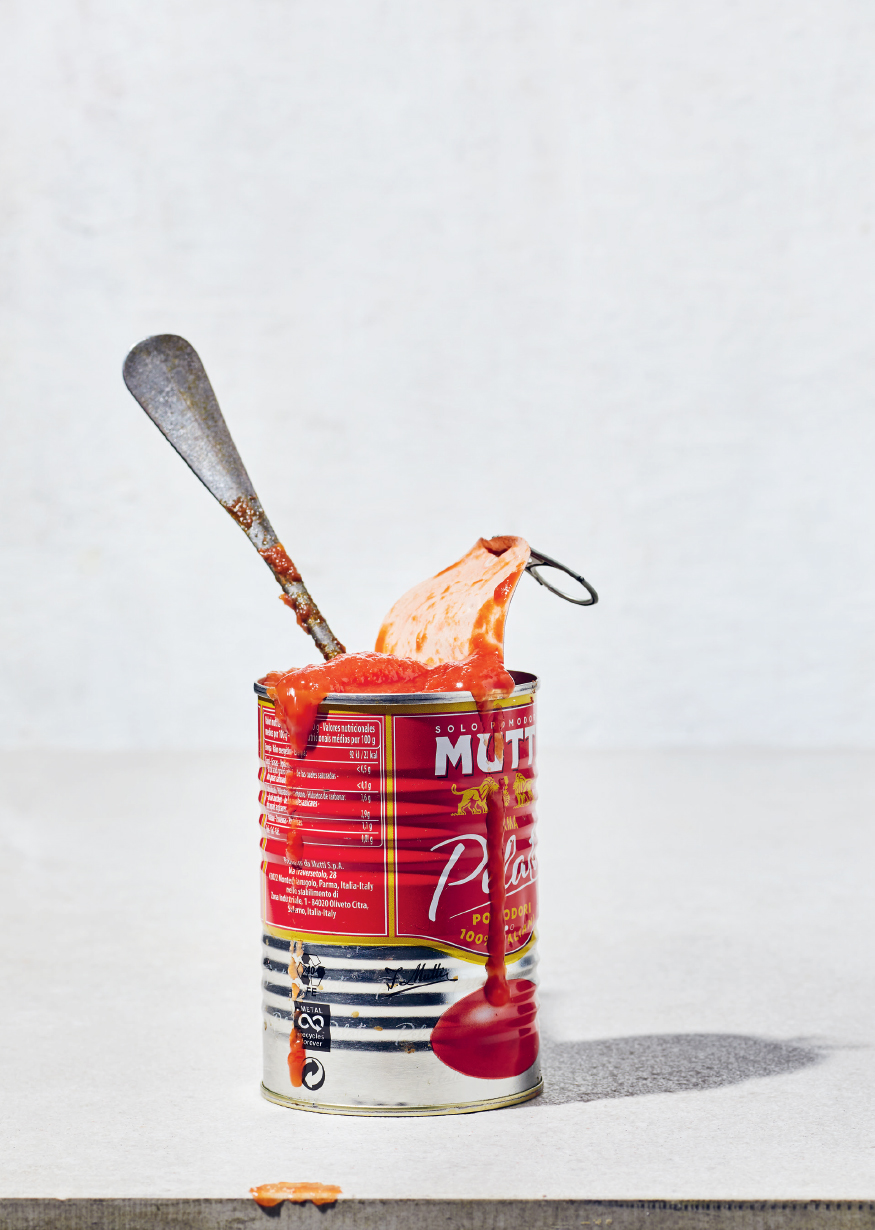
I wrote this book, and these people worked tirelessly to make it.
Sam Folan
Photographer and friend.
Matthew Williamson
Recipe developer and partner in everything.
Grace Williamson
Recipe taster #1: a winning and enthusiastic attitude to food and cooking.
Ivy Williamson
Recipe taster #2: daring and plucky, and always the first to ask, whats for dinner?
Dorothy Williamson
Recipe taster #3: never underestimated, and fearless in the face of so many tomatoes.
Faye Wears
Prop stylist wonder woman.
Judy Barratt
Red pen-wielding shapeshifter.
Harriet Webster
Editor at large.
Claire Rochford
Design is everything.
Thanks to:
Isle of Wight Tomatoes
An unstinting supply of beautiful seasonal tomatoes.
Mutti
For when the season came to an end, very best, and storecupboard staple.
Fish for Thought
Sustainably caught fish, direct to your door.
Pipers Farm
Online butcher, nothing too much trouble.
FURTHER READING
Jane Grigsons Vegetable Book
Jane Grigson
On Food and Cooking: an encyclopedia of kitchen science, history and culture
Harold McGee
The Flavour Thesaurus: pairings, recipes and ideas for the creative cook
Niki Segnit
Vegetables
Roger Phillips and Martyn Rix
Tomato: a global history
Clarissa Hyman
The Oxford Companion to Italian Food
Gillian Riley
British Tomato Growers Association
www.britishtomatoes.co.uk
Tomato Chutney
Chutney originated in India, using an age-old process devised to store fresh ingredients for enjoying at a later date, preserving with sugar, vinegar and spices, among other ingredients. Chutney-making, as it is today and now throughout much of the world, is a much-loved and common kitchen task. Served as condiment to a wide variety of savoury dishes, chutney likes to be stored for a good month before use, giving it time for the flavours to meld and helping to round off sharp corners. You need scrupulously clean jars for storing the chutney, so dont skip the first step!
MAKES 23 JARS (ABOUT 450G/1LB EACH)
800g (1lb 12oz) tomatoes, stalks removed and roughly chopped
2 large shallots or 1 onion, finely chopped
2cm (in) piece of fresh ginger, finely grated (shredded)
2 garlic cloves, finely chopped
450g (1lb) caster (superfine) sugar
200ml (7fl oz) white wine vinegar
1 teaspoon salt, plus more to season
1 teaspoon freshly ground black pepper, plus more to season
pinch of chilli flakes, or more to taste
teaspoon ground cinnamon
1 teaspoon ground cumin
1 clove
2 bay leaves
1. Sterilize your jars. Wash them in very hot soapy water or on the hot cycle of a dishwasher. Preheat the oven to 160C/140C fan/315F/Gas 23. Rinse the jars and place them upside down on a baking sheet and heat them in the oven for 10 minutes. Boil the kettle and pour boiling water over the lids to sterilize. Keep to one side with a clean, dry tea towel over the lot.
2. Put all the chutney ingredients into a large saucepan.
3. Bring the mixture to a boil over a mediumhigh heat and simmer vigorously for 10 minutes, seasoning with salt and pepper, to taste.
4. Reduce the heat to a low simmer and cook gently, stirring often, for about 11 hours, until the chutney is thick and glossy. Remove the clove if its easy to locate, not to worry if you cant track it down. Remove the bay leaves.
5. Remove the pan from the heat and carefully decant the chutney into the sterilized jars. Seal tightly with the sterilized lids and store in a cool, dry place. Sealed and stored correctly, the chutney should last indefinitely but is best consumed within a year. Once opened, store in the fridge and consume within a month or two.
Hot Sauce
Hot sauce is terrible stuff truly. So very addictive. I have been known to veto its use from time to time, at least to give some other condiments table space. I find there are not many dishes that arent improved by a splash, a slosh, and soon enough bottles and bottles of the stuff begin to accumulate in the cupboard or fridge. Youve been warned Luckily though, it is quite easy to make. Hot sauces are made in many countries throughout the world, hot from the variety of chillies used, of course, and often with added fruit for bulk and a beguiling fruitiness. Tomatoes are the fruit in this one, for their juicy, fruity weight, but Im also adding a ripe pineapple for extra tang and sweetness. Scotch bonnet chillies, a flat-bottomed and fairly diminutive-looking chilli, ubiquitous in West African and Caribbean cooking, and also called Jamaican hots, are related to the habanero. They are extremely hot, but also have a good fruitiness.
This sauce will keep for up to two weeks in the fridge. It will not last indefinitely because it has relatively low sugar and vinegar levels. That said, it is still wise to sterilize the jars or bottles. Halve the recipe, if you like, or make some to give away to friends.
MAKES ABOUT 800ML (28FL OZ)
610 scotch bonnet or habanero chillies, stems removed, roughly chopped
300g (10oz) plum or cherry tomatoes, roughly chopped
250g (9oz) pineapple, skin removed, cored and roughly diced
8 garlic cloves, roughly chopped
1 small onion, roughly chopped
100ml (3fl oz) white wine vinegar or cider vinegar
2 teaspoons salt
1. Sterilize the jars. Wash them in very hot soapy water or on the hot cycle of a dishwasher. Preheat the oven to 160C/140C fan/315F/Gas 23. Rinse the jars and place them upside down on a baking sheet and heat them in the oven for 10 minutes. Boil the kettle and pour boiling water over the lids to sterilize. Keep to one side with a clean, dry tea towel over the lot.
2. Combine all the ingredients for the hot sauce together with 150ml (5fl oz) of water in a non-reactive saucepan. Place the pan over a high heat and bring to a rapid boil, then reduce the heat and cook at a low simmer, uncovered, for 30 minutes. Remove from the heat.
3. Using a good blender, process the sauce until completely smooth. For a runnier sauce, you can add a splash of freshly boiled water. I dont bother my hot sauce is the same consistency as regular ketchup.
4. Once the sauce is smooth, carefully decant it into the sterilized jars. Cool, then store in the fridge for up to two weeks.
Ketchup
Iconic is the ketchup bottle, a bright, conspicuous red, squeezing thick stripes or noisy squirts, sweet and salty. Most children, and plenty of adults too, have an involuntary reflex with ketchup, a need to return to the bottle a second, a third, a who-am-I-to-judge time, adding more (and yet more) ketchup still to whatever ingredient is sidekick. As ketchup is easy to come by in the shops, making it is not an essential activity. Rather, it is a task to master when you have too many tomatoes you know what to hang on know perfectly well what to do with. Making your own ketchup isnt intended as some puffed-up activity, it is economical and sensible, using ingredients that are ripe and ready in profusion, and giving them a lifeline beyond just the next few days. Homemade ketchup well, its got to taste like the shop-bought stuff really, hasnt it?
Next page
